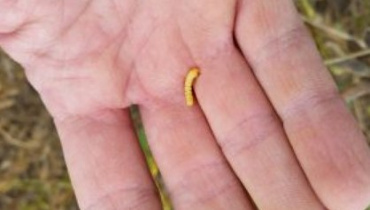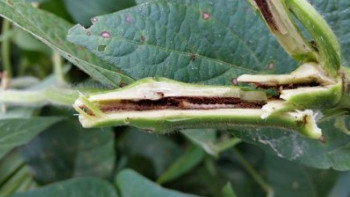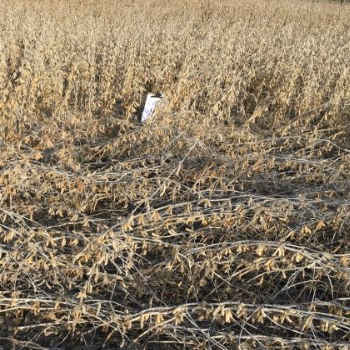
Figure 2. A larva of the dectes stem borer removed from a soybean stem
Insecticides are generally not recommended for control because the larvae are protected within the stem and the adults lay eggs over a long period of time in the summer (approximately mid-July through August in Illinois). While there appear to be some differences in varietal susceptibility, these differences are not well documented, and to my knowledge no soybean varieties have been characterized as resistant to dectes stem borer. However, there are some cultural management options available to producers:

Figure 3. Damage to the inside of a soybean stem caused by a dectes stem borer larva

Figure 4. Lodged soybeans due to dectes stem borer feeding (Photo: Eric Alinger, Dupont Pioneer)
- Monitoring. While there is no economic threshold established, finding adults at higher than average numbers will be the first indication of a problem. Note wilting or broken-off petioles, and split soybean stems toward the end of the season to gauge the level of infestation. In addition, examine soybean stems in lodged areas to determine if dectes stem borer was part of the problem. If you have never done so before and you are in southern Illinois, the results might surprise you.
- Timely harvest. Obviously, we would harvest on time every year in every field if we could. However, if you note fields that are infested with dectes stem borer, put those fields as early as possible on the priority list to reduce the potential for lodging.
- Soybean stubble. Destroying or burying soybean stubble in the fall reduces dectes numbers locally, but the adults readily move from their overwintering sites to surrounding fields. Areas with a lot of no-till production are likely to have more issues with dectes stem borer.
- Alternate hosts. Dectes stem borers feed on several other host plants, including sunflowers and giant ragweed. Areas with high populations of these plants could have higher populations of dectes stem borers as well. (As if you needed another reason to kill giant ragweed).
Source: illinois.edu